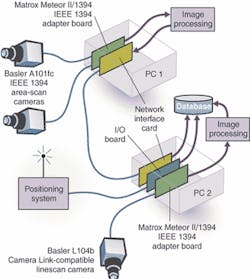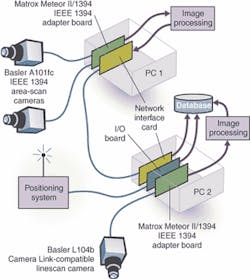Camera Link vs. 1394
Vision-system application underscores the decision-making process needed to evaluate both the Camera Link and IEEE 1394 camera interfaces.
International Cybernetics (Largo, FL, USA) develops and manufactures a variety of vision equipment used to examine and profile highways. Currently, the company is working on a new piece of equipment that will use two truck-mounted camera systems to examine the condition of highway striping and overhead signs (see figure). As the truck moves along a highway, camera system #1 uses a high-speed linescan camera to capture images of the highway striping. At the same time, camera system #2 uses two medium-resolution area-scan cameras to capture images of overhead signs. Proprietary software evaluates the condition of the striping and the signs, and a positioning system tracks the location of the truck on the highway. Condition and location information are logged into a database. State and local highway departments will use the information from the database to schedule highway maintenance.
FIGURE 1. Two IEEE 1394 cameras connected to PC 1 capture images of highway overhead signs. Proprietary image-processing software in this PC determines the condition of the signs, and the results are passed to PC 2 over a network connection. A high-speed Camera Link linescan camera connected to PC 2 captures images of painted highway stripes, and image-processing software determines the condition of the stripes. The condition information and information collected from a positioning system attached to PC 2 are logged in a database.
When the Cybernetics engineering team began development of this new vision examination system, they contacted Basler Vision Technologies (Exton, PA, USA, and Ahrensburg, Germany) and applications engineer Stan Shmia about two new camera interfaces. Although the Cybernetics engineers have considerable experience using digital cameras that have an RS-644 based interface, they wanted to explore the advantages that the Camera Link and IEEE 1394 (FireWire) interfaces might offer.
For camera system #1, an extremely high-speed linescan camera is required. Shmia comments that trying to meet this requirement reveals some of the limitations of the IEEE 1394 interface and highlights some of Camera Link's strengths (see table). Currently, the specifications that govern IEEE 1394 do not define the use of a linescan camera, so no IEEE 1394 linescan cameras are available. Also, the IEEE 1394 bus has a relatively low data rate—it can handle approximately 32 Mbytes of image data per second.
On the other hand, Camera Link line-scan cameras are readily available. And with a potential image data rate of up to approximately 650 Mbytes/s, Camera Link can easily handle the fastest linescan cameras currently available and provides room to handle even faster cameras in the future.
Another interesting consideration in regard to camera system #1 is that the standard electrical interface on Camera Link cameras and frame grabbers allows the Cybernetics engineers to test cameras from several different manufacturers with minimum effort. In the past, each camera manufacturer used different connectors, different cables, and different pin layouts on their products, which resulted in major obstacles for engineers who wanted to test products from different manufacturers head to head. The standard connectors and cabling associated with Camera Link make it easier to try different cameras during a development effort. However, designers still need to obtain a different frame-grabber configuration file for each different camera tested.
For camera system #1, Shmia points to the Camera Link cables as a major advantage over the cables used with older products. Camera Link cables are thinner, more flexible, and more robust. In the Cybernetics application where harsh highway conditions, vibrations, shock, and cable routings with tight curves are all present, the Camera Link cables are an obvious plus.
Shmia's hardware recommendations for camera system #1 included a Basler L104b 2k monochrome linescan camera coupled with a Matrox Imaging (Dorval, Quebec, Canada) Meteor II/CL frame grabber. The L104b is Camera Link-compatible with a 31.25-MHz pixel clock (in dual output mode) and a 29.2-kHz line rate. At this line rate, the camera can capture high-resolution images of the highway striping even when the Cybernetics vehicle is traveling at highway speeds. The camera is designed to use the Camera Link Base configuration. The Matrox frame grabber can acquire up to 40 MHz and can therefore easily handle the 31.25-MHz rate of the L104b. The board is designed to handle all three Channel Link configurations.
Different ChallengesCamera system #2 posed a different set of challenges. The Cybernetics engineers specified that they needed two medium-resolution area-scan cameras and that the cameras must be connected to a single computer. Since the overhead signs that these cameras image remain in view for a relatively long period of time, high-frame rates are not required. However, because lighting conditions can change dramatically with travel time, the cameras must be able to be re-parameterized quickly.Shmia concluded that cameras using the IEEE 1394 interface were well suited for this situation. Using an inexpensive interface board, two cameras can be easily connected to a single computer. In fact, the ability to connect multiple cameras to a single bus at low cost is an outstanding advantage of the IEEE 1394 interface. He also points out that the bidirectional nature of the IEEE 1394 bus allows attached cameras to be reparameterized before each image acquisition with little or no effect on the frame rate. Moreover, as with Camera Link, the cables used with the IEEE 1394 interface are flexible and robust. The IEEE 1394 cables have an additional advantage in that they are widely used in many video applications. As a result, they are readily available and tend to be less expensive than the cables used with Camera Link.
For system #2, Shmia's hardware recommendation was to couple two Basler A101fc IEEE 1394 color area-scan cameras with a Matrox Meteor II/1394 adapter card. The A101fc cameras provide a resolution of 1300 x 1030 pixels and a maximum 11.75-frame/s rate. At this speed and resolution, they can provide high-quality images to the system's overhead-sign-condition analysis software. When these cameras operate at full resolution and frame rate, they generate approximately 15 Mbytes/s of image data per camera or a total of 30 Mbytes/s for the two cameras. The generated data are within the maximum 32-Mbyte capacity of the IEEE 1394 bus. Consequently, the two cameras can be attached to a single adapter card while operating at full resolution and frame rate.
The Matrox Meteor II/1394 adapter card has three IEEE 1394 ports, allowing the two A101fc cameras to be connected directly to the board. Moreover, this board has an internal connection to the power supply in the host PC. This connection allows the board to supply sufficient power to the two A101fc cameras via the IEEE 1394 cables.
ANTHONY PIERI is senior technical writer at Basler Vision Technologies, Exton, PA 19341.


